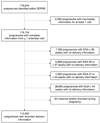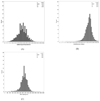Implementation of the Zambia electronic perinatal record system for comprehensive prenatal and delivery care
- PMID: 21315347
- PMCID: PMC3071887
- DOI: 10.1016/j.ijgo.2010.11.013
Implementation of the Zambia electronic perinatal record system for comprehensive prenatal and delivery care
Abstract
Objective: To characterize prenatal and delivery care in an urban African setting.
Methods: The Zambia Electronic Perinatal Record System (ZEPRS) was implemented to record demographic characteristics, past medical and obstetric history, prenatal care, and delivery and newborn care for pregnant women across 25 facilities in the Lusaka public health sector.
Results: From June 1, 2007, to January 31, 2010, 115552 pregnant women had prenatal and delivery information recorded in ZEPRS. Median gestation age at first prenatal visit was 23weeks (interquartile range [IQR] 19-26). Syphilis screening was documented in 95663 (83%) pregnancies: 2449 (2.6%) women tested positive, of whom 1589 (64.9%) were treated appropriately. 111108 (96%) women agreed to HIV testing, of whom 22% were diagnosed with HIV. Overall, 112813 (98%) of recorded pregnancies resulted in a live birth, and 2739 (2%) in a stillbirth. The median gestational age was 38weeks (IQR 35-40) at delivery; the median birth weight of newborns was 3000g (IQR 2700-3300g).
Conclusion: The results demonstrate the feasibility of using a comprehensive electronic medical record in an urban African setting, and highlight its important role in ongoing efforts to improve clinical care.
Copyright © 2010 International Federation of Gynecology and Obstetrics. Published by Elsevier Ireland Ltd. All rights reserved.
Conflict of interest statement
The authors have no conflicts of interest.
Figures


References
-
- Rosenfield A, Maine D. Maternal mortality—a neglected tragedy. Where is the M in MCH? Lancet. 1985;2(8446):83–85. - PubMed
-
- Bugalho A, Bergstrom S. Value of perinatal audit in obstetric care in the developing world: a ten-year experience of the Maputo model. Gynecol Obstet Invest. 1993;36(4):239–243. - PubMed
-
- Pattinson R, Kerber K, Waiswa P, LDay LT, Mussell F, Asiruddin SK, et al. Perinatal mortality audits: counting, accountability, and overcoming challenges in scaling up low- and middle-income countries. Int J Gynaecol Obstet. 2009;107(Suppl 1):S113–S121. S121–S122. - PubMed
-
- Garrib A, Stoops N, McKenzie A, Dlamini L, Govender T, Rohde J, et al. An evaluation of the District Health Information System in rural South Africa. S Afr Med J. 2008;98(7):549–552. - PubMed
Publication types
MeSH terms
Grants and funding
LinkOut - more resources
Full Text Sources
Medical
Miscellaneous

